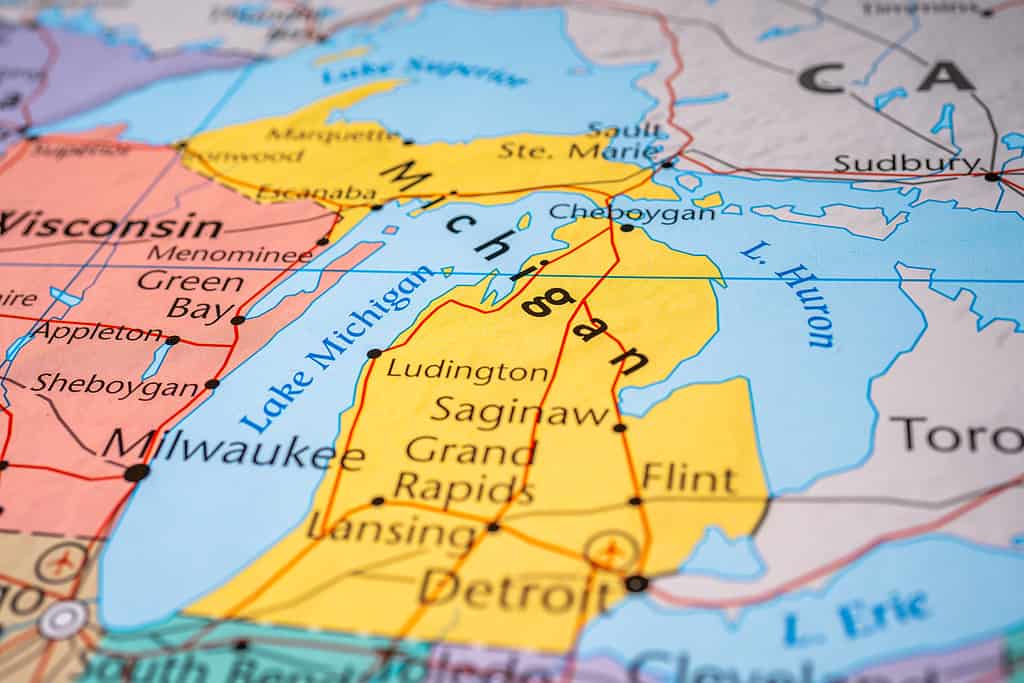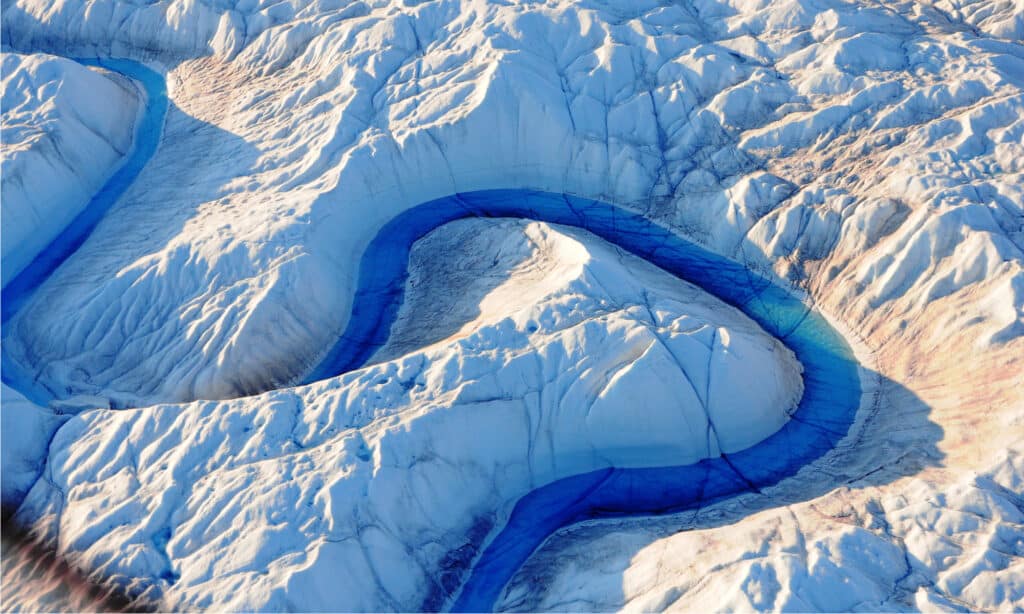Michigan is the only state in the United States divided into two peninsulas. Some people think the Lower Peninsula resembles a mitten. Most of the state gets its shape from the Great Lakes that surround it. The Upper Peninsula shares a land border with Wisconsin, but water divides it from the rest of Michigan. So, why isn’t this top portion part of Wisconsin? Exactly how did Michigan get its unique shape? This article looks at how the Great Lakes formed, creating the long coastline of the state. It also discusses how government officials chose the land borders of Michigan.

Michigan is made up of two peninsulas surrounded by four of the five Great Lakes.
©Alexander Lukatskiy/Shutterstock.com
Michigan’s Geography
Michigan is in the Great Lakes basin between Lakes Superior, Michigan, and Huron, with a shorter coastline on Lake Erie to the southeast. Because of this, we can’t tell the story of Michigan’s shape without exploring where these lakes came from. Geologists tell us that the planet went through an ice age that lasted from about 100,000 years ago to 20,000 years ago.
During this period, Michigan and the Great Lakes region were under a mile-thick sheet of ice that covered most of Canada and the Northern United States. The stupendous weight and movement of this ice sheet formed the lake basins. Approximately 20,000 years ago, the climate went into a warming period that continues today, now greatly accelerated by human activities. As the glaciers melted, the basins filled with runoff water, forming the Great Lakes. They fully reached their current shapes and sizes about 3,000 years ago. The shape of the lakes is a partial answer to the question, “How did Michigan get its unique shape?”

Greenland’s Blue River shows what melting ice sheets that formed the Great Lakes may have looked like.
©Daphne Nilsson/Shutterstock.com
Michigan’s History
For thousands of years, Native American tribes lived in the territory of Michigan. In fact, the name of the state itself comes from the Ojibwe word mishigami meaning, “large water” or “large lake.” French explorers claimed it in the 17th century, focusing on fur trading with local indigenous tribes. When France lost the 7 Years War in 1762, the area of Michigan and other French possessions east of the Mississippi River became part of the British empire. And with American independence in 1781, the territory became part of the United States. So, how did officials draw state borders between Michigan, Wisconsin, Indiana, and Ohio?
Boarder Disputes
At first, Michigan was part of the Northwest Territory. In 1800, it was divided vertically right down the middle of the Lower Peninsula, with the western half joined to Indiana and the eastern half to Ohio. The Michigan Territory was carved off as a separate territory in 1805. Thirty years later, the population of the territory had grown enough to apply for statehood. However, this process was delayed because of a border dispute with Ohio, known as the Toledo War.
Both sides claimed a strip of land running from the present border of Indiana to Lake Erie that included the city of Toledo, the mouth of the Maumee River (and access to inland shipping), and good farmland. Both sides deployed militias to the area, but no actual “war” was fought. To resolve the conflict, Congress proposed giving the Toledo strip to Ohio and compensating Michigan with the Upper Peninsula. Michigan citizens thought this was a bad deal, but the mineral wealth of the Upper Peninsula was ultimately very profitable for the state. With this problem solved, Michigan became the 26th state in 1837.

Toledo is part of Ohio, but if things had turned out differently, it might have been a part of Michigan.
©Sean Pavone/Shutterstock.com
Why Are Michiganders Called “Wolverines?”
Sometime around the Toledo war, Michiganders became known by the nickname “wolverines.” Wolverines are strong carnivorous mammals that are reputed for being startlingly tenacious and ferocious. They are about as big as a medium-sized dog, are built low to the ground with muscular legs, and have water-resistant fur that helps them stay warm and dry in water or snow. They are ravenous and undiscriminating eaters, which is why they are also sometimes called “gluttons.” People in Michigan may have given the name “wolverine” to themselves as a boast of their fiestiness and strength, or it may have been pinned on them by Ohioans as an insult based on the piggish habits of wolverines. Either way, the name stuck and the wolverine became the state animal, the namesake of the University of Michigan football team, and a proud name for Michiganders themselves.

Wolverines are fierce, tenacious, strong fighters who can take down prey larger than themselves.
©Maksim – Public Domain by US National Park Service – Original / License
Comparison of the Upper and Lower Peninsulas
Similarities
The Upper and Lower Peninsulas have some similarities, but in many ways the differences surpass them. Together they have the longest freshwater coastline of any state in the United States, with sand dune and wetlands habitats. The Upper Peninsula and the northern part of the Lower Peninsula are heavily forested. Both have a humid continental climate and heavy snows in the winter. Both have great fishing and hunting. Bears, moose, white-tailed deer, river otters, wolves, bobcats, coyotes, and wolverines (the state animal) are some of the major wildlife species that find abundant habitat in both parts of the state. Both parts of the state get a lot of tourism, but the more pristine and remote Upper Peninsula tends to attract visitors from the upper Midwest, while the cities of the Lower Peninsula draw people from all over the country and around the world.

Both parts of Michigan get a lot of snow, which makes it a great place for cross-country skiing.
©Christopher Tipton/Shutterstock.com
Differences
By far the vast majority of the state population lives in the Lower Peninsula. This part of the state has more farmland and is also more industrialized and urbanized. The population is wealthier, has a higher education level, is more diverse, and leans more politically to the left. The Upper Peninsula doesn’t have large cities like Detroit; the largest city there is Marquette with a population of about 20,000 people. Mining and lumber are two of the key industries in the Upper Peninsula. The region tends to be more socially and politically conservative. Remarkably, it was impossible to travel between the two parts of Michigan by anything but boat until the 1957, when the five-mile Mackinac suspension bridge (the “Big Mac”) was built to connect them.

The Mackinac suspension bridge was completed in 1957.
©Steve Gadomski/Shutterstock.com
Two Parts, One State
Just looking casually at the map of the United States, it’s understandable that many people would wonder, “How did Michigan get it’s unique shape?” We’ve seen that it resulted from a combination of geography and history. Michigan is the largest state east of the Mississippi River, so the distances separating the two peninsulas physically contribute to some cultural, economic, and demographic differences. But none of those differences are great enough to overcome the two parts of the state’s shared geography, culture, and history. Michiganders are united not just by a bridge, but by their proud shared identity as Wolverines.
Thank you for reading! Have some feedback for us? Contact the AZ Animals editorial team.








